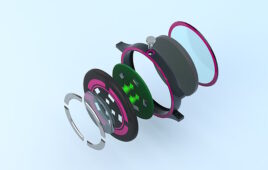As per a new report published by Global Market Insights Inc., the hot-melt adhesives market was estimated at U.S. $12.25 billion in 2021 and is projected to exceed $19.35 billion in revenue by 2028 — progressing at a CAGR of 7% from 2022 to 2028.

Click here to download a free sample of this report.
There is a reason for this. Hot-melt adhesives have a long shelf life, low environmental effects, and tamper-resistant seals, which have boosted product use in several applications. Examples include binding (such as with book covers), profile wrapping, and closing the flaps of corrugated boxes. Rapid R&D activities in the field are likely to further propel the hot-melt market growth through the forecasted time span.
The shift in consumer preferences for low-price an convenience plastic products should further drive industry growth.
The styrenic block copolymer (SBC)-based hot-melt adhesives enhance the bonding of lycra rubber strands and rubber and adherence of elastic strands to polyolefin, which has bolstered its usage in diaper manufacturing. Rising awareness regarding hygiene and cleanliness, along with a surge in disposable income of consumers, would further impel product uptake.
On account of these factors, the SBC product segment is slated to exceed a valuation of $2.05 billion by the end of 2028.
Meanwhile, the polyurethane (PU) product segment was valued at over $840 million in 2021 and is expected to gain traction over the forecast period. PU hot melts are majorly used in the electronics industry and pharmaceuticals, cosmetics, perfumes & beauty products packaging due to their flexibility, moisture & temperature resistance, and good adhesion to a wide range of substances.
EVA hot-melt products also have a wide application scope in woodworking, automobile, and paper industries due to their dependability, intact adhesion, versatility & durability. These adhesives are specially developed to adhere to paper stock, aqueous coating, paper, and waxes, thereby promoting their uses in the packaging industry for labeling, carton sealing, plastic films & card stock boxes.
EVA hot-melt adhesives market surpassed $5.30 billion in 2021 and is likely to register a CAGR of over 7.5% from 2022 to 2028 owing to the shift in consumer preferences for well-packed products along with supporting FDA regulations regarding direct or indirect food contact. The rise in the awareness regarding harmful effects of high-VOC content stimulate the product demand in the automotive sector.
Automobile’ segment retaining its dominance
The hot-melt adhesives industry from the automobile segment is anticipated to reach about $1.45 billion in revenue by the end of the study period. Hot melts can be used as an alternative to mechanical fasteners in the automotive sector for making vehicles lightweight and fuel-efficient. A positive stance toward automotive manufacturing, along with R&D expenditure on product innovation, mainly in China and the U.S., is likely to propel market expansion.
Key reasons for the hot-melt adhesives market growth:
1. Expanding product usage across automotive industry.
2. Growing demand for polyurethane hot melt adhesives.
3. High adoption of SBC hot-melt adhesives in diaper manufacturing.
Major companies functioning in the hot melt adhesives market include Henkel, H.B. Fuller, Arkema, 3M, Dow Chemical Company, Sika AG, Ashland, and others.
North American development
North America hot-melt adhesives market size surpassed $3.45 billion in 2021 and is likely to register over 7% gains through 2028 owing to growing electronics, healthcare, and automotive industries. Hot melts possess high heat resistance, which increases their suitability for high-temperature applications such as insulation panels, vinyl gaskets, touchpads, and nameplates.
Booming paper, board and packaging industries should further stimulate product demand on account of the rising demand for attractive cases for perfumes, cosmetics NS pharmaceutical products.
Rise in online shopping trends has led to increase in shipping label, tapes and canton sealing requirements thereby stimulating regional growth. Supporting FDA regulations regarding food contact materials has led to increase in use of hot-melt adhesives in food labelling and packaging. Rising packed food consumption owing to hectic lifestyle prominently in U.S should drive regional market size.









Tell Us What You Think!